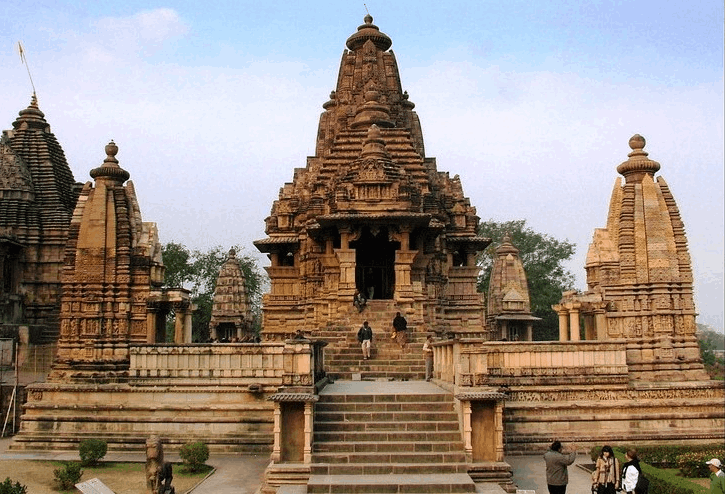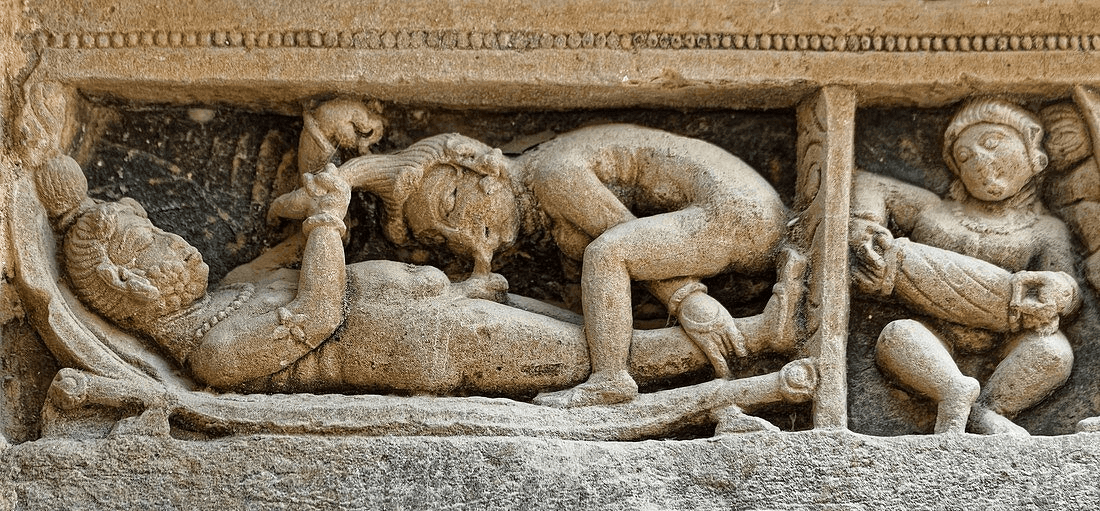The Lakshmana Temple at Khajuraho stands as a magnificent testament to the artistry, religious fervor, and architectural ingenuity of ancient India. Part of the Khajuraho Group of Monuments, this temple is not only a crucial element of the UNESCO World Heritage site but also a significant exemplar of the Chandela dynasty’s architectural prowess. This comprehensive study delves into the temple’s history, architecture, iconography, and cultural importance, providing an in-depth understanding of its place in India’s rich historical tapestry.
Historical Context for Lakshmana Temple at Khajuraho
The Chandela Dynasty
The Lakshmana Temple was constructed during the reign of the Chandela dynasty, which ruled central India from the 9th to the 13th centuries. The Chandela rulers were known for their patronage of art and architecture, leaving behind a legacy of magnificent temples and sculptures. The dynasty’s influence was particularly strong in the region of Bundelkhand, where Khajuraho is located.
Khajuraho, once known as Kharjuravahaka, meaning ‘the land of date palms,’ became a prominent cultural and religious center under the Chandelas. The rulers of this dynasty were devout followers of Hinduism and Jainism, and their dedication to religious practices is reflected in the temples they constructed.
Construction and Commission
The Lakshmana Temple was built in the early 10th century, around 954 AD, under the patronage of King Yashovarman, a prominent Chandela ruler. This period was marked by a flourishing of art and architecture, and the construction of the Lakshmana Temple was a significant event in this cultural renaissance.
The temple was dedicated to Vishnu, one of the principal deities of Hinduism, and it reflects the religious and cultural ethos of the time. It was constructed in a period of relative stability and prosperity, which allowed for the elaborate and detailed craftsmanship seen in the temple.

Architectural Excellence of Lakshmana Temple at Khajuraho
Layout and Structure
The Lakshmana Temple is renowned for its architectural brilliance and intricate design. It is a part of the western group of temples in Khajuraho and stands as one of the best-preserved examples of Chandela architecture.
Plan and Elevation
The temple follows the classic Nagara style of Hindu temple architecture. It consists of three main components: the sanctum (garbhagriha), the vestibule (antarala), and the hall (mandapa). The sanctum houses the principal deity, Vishnu, and is designed to be the focal point of the temple.
The temple is constructed on a high plinth, which elevates the structure and provides a sense of grandeur. The main shrine is surrounded by a series of smaller shrines and a large, intricately carved frieze.
Shikhara (Tower)
The Lakshmana Temple is distinguished by its soaring shikhara, or tower, which rises majestically above the sanctum. The shikhara is adorned with detailed carvings and is a hallmark of Chandela temple architecture. It represents the mythical Mount Meru, considered the center of the universe in Hindu cosmology.
Mandapa
The mandapa is an open hall with intricately carved pillars and a beautifully sculpted ceiling. This space serves as a gathering area for devotees and allows for the performance of rituals and ceremonies. The mandapa’s design is both functional and aesthetically pleasing, reflecting the temple’s architectural sophistication.
Sculptural Decorations
The Lakshmana Temple is celebrated for its exquisite sculptures, which cover almost every surface of the structure. These sculptures are not merely decorative but carry deep symbolic and religious meanings.
Main Deity and Iconography
The principal deity of the Lakshmana Temple is Vishnu, depicted in his various avatars. The most prominent figure is the Vishnu image in the sanctum, which is flanked by two other deities: Lakshmi, the goddess of wealth and prosperity, and Garuda, Vishnu’s mount. This triad of deities is central to the temple’s iconography and underscores the temple’s dedication to Vishnu.
Erotic Sculptures
One of the most striking features of the Lakshmana Temple is its erotic sculptures. These carvings depict various aspects of human life and relationships, including romantic and erotic themes. While these sculptures might seem out of place, they are integral to the temple’s artistic expression. They represent the celebration of life and the belief that spirituality and sensuality are interconnected aspects of existence.
Mythological and Symbolic Carvings
In addition to erotic sculptures, the temple is adorned with numerous mythological and symbolic carvings. These include depictions of Hindu deities, celestial beings, and scenes from Hindu epics like the Ramayana and the Mahabharata. The intricate detailing and narrative quality of these carvings provide valuable insights into the religious and cultural beliefs of the time.

Cultural and Religious Significance of Lakshmana Temple at Khajuraho
Religious Practices
The Lakshmana Temple, like other Khajuraho temples, was designed to facilitate various Hindu rituals and ceremonies. The temple’s layout and architectural features are aligned with Vedic principles, ensuring that it serves as a functional space for worship.
Worship and Rituals
In ancient times, the temple would have been a vibrant center of religious activity, with daily rituals, festivals, and ceremonies taking place. The sanctum, or garbhagriha, would have been the focal point for offerings and prayers to Vishnu.
Pilgrimage
Khajuraho was an important pilgrimage site, attracting devotees from across the Indian subcontinent. The temples, including the Lakshmana Temple, were considered sacred spaces where pilgrims could seek blessings and perform rituals. The grandeur of the temples and the intricate artistry would have enhanced the spiritual experience for the devotees.
Cultural Impact of Lakshmana Temple at Khajuraho
The Lakshmana Temple, along with other temples in Khajuraho, has had a lasting impact on Indian art and architecture. Its innovative design and artistic achievements have inspired generations of architects and artists.
Architectural Influence
The architectural style of the Lakshmana Temple has influenced subsequent temple constructions in India. The use of intricate carvings, the elevation of the temple on a high plinth, and the design of the shikhara have all become hallmarks of Hindu temple architecture.
Artistic Legacy
The temple’s sculptures and carvings have left a lasting legacy in Indian art. The depiction of various aspects of life and the integration of eroticism with spirituality have been subjects of study and admiration. The temple’s artistic achievements continue to be celebrated and studied by scholars and art enthusiasts.
Preservation and Modern Significance of Lakshmana Temple at Khajuraho
Conservation Efforts
The Lakshmana Temple has been the focus of various conservation efforts to preserve its architectural and artistic integrity. The temple, along with other Khajuraho monuments, has faced challenges related to weathering, pollution, and human impact.
Restoration Work
Over the years, there have been numerous restoration projects aimed at preserving the temple’s structure and artwork. These efforts have included cleaning, repairing, and stabilizing the temple’s carvings and architecture.
UNESCO Recognition
In 1986, the Khajuraho Group of Monuments, including the Lakshmana Temple, was designated as a UNESCO World Heritage site. This recognition has helped raise awareness about the importance of preserving these historical and cultural treasures.

Tourism and Education Lakshmana Temple at Khajuraho
The Lakshmana Temple attracts tourists, scholars, and devotees from around the world. Its significance as a cultural and historical landmark has made it an important destination for those interested in India’s architectural and religious heritage.
Tourism
Tourism plays a vital role in the local economy, providing visitors with the opportunity to explore the temple’s beauty and learn about its history. The temple’s inclusion in guided tours and cultural programs helps promote understanding and appreciation of its significance.
Educational Programs
Educational programs and research initiatives focus on the study of the Lakshmana Temple and other Khajuraho monuments. These programs aim to deepen knowledge about the temple’s history, architecture, and cultural context, contributing to its ongoing preservation and appreciation.
Conclusion
The Lakshmana Temple at Khajuraho stands as a remarkable example of ancient Indian architecture and artistry. Its historical significance, architectural brilliance, and cultural impact make it a key element of the Khajuraho Group of Monuments. The temple’s intricate sculptures, innovative design, and religious significance reflect the rich heritage of the Chandela dynasty and the broader Indian cultural landscape.
As a UNESCO World Heritage site, the Lakshmana Temple continues to inspire and captivate visitors from around the world. Its preservation and ongoing study ensure that future generations will have the opportunity to appreciate and learn from this extraordinary example of India’s architectural and artistic legacy.
